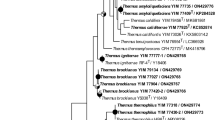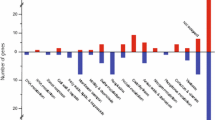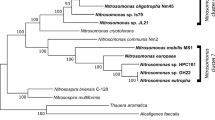Abstract
Hot spring ecosystems are analogous to some thermal environments on the early Earth and represent ideal models to understand life forms and element cycling on the early Earth. Denitrification, an important component of biogeochemical nitrogen cycle, is highly active in hot springs. Nitrite (NO2−) reduction to nitric oxide (NO) is the significant and rate-limiting pathway in denitrification and is catalyzed by two types of nitrite reductases, encoded by nirS and nirK genes. NirS and NirK were originally considered incompatible in most denitrifying organisms, although a few strains have been reported to possess both genes. Herein, we report the functional division of nirS and nirK in Thermus, a thermophilic genus widespread in thermal ecosystems. Transcriptional levels of nirS and nirK coexisting in Thermus antranikianii DSM 12462T were measured to assess the effects of nitrite, oxygen, and stimulation time. Thirty-nine Thermus strains were used to analyze the phylogeny and distribution of nirS and nirK; six representative strains were used to assess the denitrification phenotype. The results showed that both genes were actively transcribed and expressed independently in T. antranikianii DSM 12462T. Strains with both nirS and nirK had a wider range of nitrite adaptation and revealed nir-related physiological adaptations in Thermus: nirK facilitated adaptation to rapid changes and extended the adaptation range of nitrite under oxygen-limited conditions, while nirS expression was higher under oxic and relatively stable conditions.








Similar content being viewed by others
References
Lehnert N, Dong HT, Harland JB, Hunt AP, White CJ (2018) Reversing nitrogen fixation. Nat Rev Chem 2:278–289. https://doi.org/10.1038/s41570-018-0041-7
Casciotti KL (2016) Nitrogen and oxygen isotopic studies of the marine nitrogen cycle. Annu Rev Mar Sci. 8:379–407. https://doi.org/10.1146/annurev-marine-010213-135052
Fukuda Y, Tse KM, Lintuluoto M, Fukunishi Y, Mizohata E, Matsumura H, Takami H, Nojiri M, Inoue T (2014) Structural insights into the function of a thermostable copper-containing nitrite reductase. J Biochem. 155:123–135. https://doi.org/10.1093/jb/mvt107
Schreiber K, Krieger R, Benkert B, Eschbach M, Arai H, Schobert M, Jahn D (2007) The anaerobic regulatory network required for Pseudomonas aeruginosa nitrate respiration. J. Bacteriol. 189:4310–4314. https://doi.org/10.1128/JB.00240-07
Zumft WG, Kroneck PM (2007) Respiratory transformation of nitrous oxide (N2O) to dinitrogen by Bacteria and Archaea. Adv Microb Physiol 52:107–227. https://doi.org/10.1016/s0065-2911(06)52003-x
Meng Q, Yin J, Jin M, Gao H (2018) Distinct nitrite and nitric oxide physiologies in Escherichia coli and Shewanella oneidensis. Appl. Environ. Microbiol. 84:e00559–e00518. https://doi.org/10.1128/AEM.00559-18
Goregues CM, Michotey VD, Bonin PC (2005) Molecular, biochemical, and physiological approaches for understanding the ecology of denitrification. Microb. Ecol. 49:198–208. https://doi.org/10.1007/s00248-004-0256-7
Gregory LG, Bond PL, Richardson DJ, Spiro S (2003) Characterization of a nitrate-respiring bacterial community using the nitrate reductase gene (narG) as a functional marker. Microbiology 149:229–237. https://doi.org/10.1099/mic.0.25849-0
Yuan Q, Liu P, Lu Y (2012) Differential responses of nirK- and nirS-carrying bacteria to denitrifying conditions in the anoxic rice field soil. Environ. Microbiol. Rep. 4:113–122. https://doi.org/10.1111/j.1758-2229.2011.00311.x
Shi Y, Liu X, Zhang Q (2019) Effects of combined biochar and organic fertilizer on nitrous oxide fluxes and the related nitrifier and denitrifier communities in a saline-alkali soil. Sci. Total Environ. 686:199–211. https://doi.org/10.1016/j.scitotenv.2019.05.394
Zumft WG (1997) Cell biology and molecular basis of denitrification. Microbiol Mol Biol Rev 61:533–616
Jones CM, Hallin S (2010) Ecological and evolutionary factors underlying global and local assembly of denitrifier communities. ISME J 4:633–641. https://doi.org/10.1038/ismej.2009.152
Coyne MS, Arunakumari A, Averill BA, Tiedje JM (1989) Immunological identification and distribution of dissmiliratory heme cd1 and non-heme copper nitrite reductases in denitrifying bacteria. Appl Environ Microbiol 55:2924–2931
Jones CM, Stres B, Rosenquist M, Hallin S (2008) Phylogenetic analysis of nitrite, nitric oxide, and nitrous oxide respiratory enzymes reveal a complex evolutionary history for denitrification. Mol Biol Evol 25:1955–1966. https://doi.org/10.1093/molbev/msn146
Graf DR, Jones CM, Hallin S (2014) Intergenomic comparisons highlight modularity of the denitrification pathway and underpin the importance of community structure for N2O emissions. PLoS One 9:e114118. https://doi.org/10.1371/journal.pone.0114118
Costa KC, Navarro JB, Shock EL, Zhang CL, Soukup D, Hedlund BP (2009) Microbiology and geochemistry of great boiling and mud hot springs in the United States Great Basin. Extremophiles 13:447–459. https://doi.org/10.1007/s00792-009-0230-x
Dodsworth JA, Hungate BA, Hedlund BP (2011) Ammonia oxidation, denitrification and dissimilatory nitrate reduction to ammonium in two US Great Basin hot springs with abundant ammonia-oxidizing archaea. Environ Microbiol 13:2371–2386. https://doi.org/10.1111/j.1462-2920.2011.02508.x
Cava F, Zafra O, da Costa MS, Berenguer J (2008) The role of the nitrate respiration element of Thermus thermophilus in the control and activity of the denitrification apparatus. Environ Microbiol 10:522–533. https://doi.org/10.1111/j.1462-2920.2007.01472.x
Hedlund BP, McDonald AI, Lam J, Dodsworth JA, Brown JR, Hungate BA (2011) Potential role of Thermus thermophilus and T. oshimai in high rates of nitrous oxide (N2O) production in approximately 80°C hot springs in the US Great Basin. Geobiology 9:471–480. https://doi.org/10.1111/j.1472-4669.2011.00295.x
Brock TD, Freeze H (1969) Thermus aquaticus gen. n. and sp. n., a nonsporulating extreme thermophile. J Bacteriol 98:289–297
Khan IU, Habib N, Hussain F, Xian WD, Amin A, Zhou EM, Ahmed I, Zhi XY, Li WJ (2017) Thermus caldifontis sp. nov., a thermophilic bacterium isolated from a hot spring. Int J Syst Evol Microbiol 67:2868–2872. https://doi.org/10.1099/ijsem.0.002037
Chung AP, Rainey FA, Valente M, Nobre MF, da Costa MS (2000) Thermus igniterrae sp. nov. and Thermus antranikianii sp. nov., two new species from Iceland. Int J Syst Evol Microbiol 50(Pt 1):209–217. https://doi.org/10.1099/00207713-50-1-209
Yu TT, Ming H, Yao JC, Zhou EM, Park DJ, Hozzein WN, Kim CJ, Wadaan MA, Li WJ (2015) Thermus amyloliquefaciens sp. nov., isolated from a hot spring sediment sample. Int J Syst Evol Microbiol 65:2491–2495. https://doi.org/10.1099/ijs.0.000289
Delorme S, Philippot L, Edel-Hermann V, Deulvot C, Mougel C, Lemanceau P (2003) Comparative genetic diversity of the narG, nosZ, and 16S rRNA genes in fluorescent pseudomonads. Appl Environ Microbiol 69:1004–1012. https://doi.org/10.1128/aem.69.2.1004-1012.2003
Robinson JL, Jaslove JM, Murawski AM, Fazen CH, Brynildsen MP (2017) An integrated network analysis reveals that nitric oxide reductase prevents metabolic cycling of nitric oxide by Pseudomonas aeruginosa. Metab. Eng. 41:67–81. https://doi.org/10.1016/j.ymben.2017.03.006
Braker G, Fesefeldt A, Witzel KP (1998) Development of PCR primer systems for amplification of nitrite reductase genes (nirK and nirS) to detect denitrifying bacteria in environmental samples. Appl Environ Microbiol 64:3769–3775
Alvarez L, Quintans NG, Blesa A, Baquedano I, Mencia M, Bricio C, Berenguer J (2017) Hierarchical control of nitrite respiration by transcription factors encoded within mobile gene clusters of Thermus thermophilus. Genes (Basel) 8:8. https://doi.org/10.3390/genes8120361
Cava F, Laptenko O, Borukhov S, Chahlafi Z, Blas-Galindo E, Gomez-Puertas P, Berenguer J (2007) Control of the respiratory metabolism of Thermus thermophilus by the nitrate respiration conjugative element NCE. Mol Microbiol 64:630–646. https://doi.org/10.1111/j.1365-2958.2007.05687.x
Chahlafi Z, Alvarez L, Cava F, Berenguer J (2018) The role of conserved proteins DrpA and DrpB in nitrate respiration of Thermus thermophilus. Environ Microbiol 20:3851–3861. https://doi.org/10.1111/1462-2920.14400
Bowman LA, McLean S, Poole RK, Fukuto JM (2011) The diversity of microbial responses to nitric oxide and agents of nitrosative stress close cousins but not identical twins. Adv Microb Physiol 59:135–219. https://doi.org/10.1016/b978-0-12-387661-4.00006-9
Stern AM, Zhu J (2014) An introduction to nitric oxide sensing and response in bacteria. Adv Appl Microbiol 87:187–220. https://doi.org/10.1016/b978-0-12-800261-2.00005-0
Sanchez C, Minamisawa K (2018) Redundant roles of Bradyrhizobium oligotrophicum cu-type (NirK) and cd1-type (NirS) nitrite reductase genes under denitrifying conditions. FEMS Microbiol Lett. 365. https://doi.org/10.1093/femsle/fny015
Campbell MA, Nyerges G, Kozlowski JA, Poret-Peterson AT, Stein LY, Klotz MG (2011) Model of the molecular basis for hydroxylamine oxidation and nitrous oxide production in methanotrophic bacteria. FEMS Microbiol Lett. 322:82–89. https://doi.org/10.1111/j.1574-6968.2011.02340.x
Jang J, Ashida N, Kai A, Isobe K, Nishizawa T, Otsuka S, Yokota A, Senoo K, Ishii S (2018) Presence of cu-type (NirK) and cd1-type (NirS) nitrite reductase genes in the denitrifying bacterium Bradyrhizobium nitroreducens sp. nov. Microbes Environ. 33:326–331. https://doi.org/10.1264/jsme2.ME18039
Lycus P, Soriano-Laguna MJ, Kjos M, Richardson DJ, Gates AJ, Milligan DA, Frostegard A, Bergaust L, Bakken LR (2018) A bet-hedging strategy for denitrifying bacteria curtails their release of N2O. Proc Natl Acad Sci U S A. 115:11820–11825. https://doi.org/10.1073/pnas.1805000115
Green MR, Sambrook J (2018, 2018) Constructing a standard curve for real-time polymerase chain reaction (PCR) experiments. Cold Spring Harb Protoc 2018. https://doi.org/10.1101/pdb.prot095026 pdb.prot095026
Bustin SA, Benes V, Garson JA, Hellemans J, Huggett J, Kubista M, Mueller R, Nolan T, Pfaffl MW, Shipley GL, Vandesompele J, Wittwer CT (2009) The MIQE guidelines: minimum information for publication of quantitative real-time PCR experiments. Clin Chem 55:611–622. https://doi.org/10.1373/clinchem.2008.112797
Livak KJ, Schmittgen TD (2001) Analysis of relative gene expression data using real-time quantitative PCR and the 2(−delta delta C(T)) method. Methods (San Diego, Calif) 25:402–408. https://doi.org/10.1006/meth.2001.1262
Singh P, Singh MK, Beg YR, Nishad GR (2019) A review on spectroscopic methods for determination of nitrite and nitrate in environmental samples. Talanta 191:364–381. https://doi.org/10.1016/j.talanta.2018.08.028
Wang QH, Yu LJ, Liu Y, Lin L, Lu RG, Zhu JP, He L, Lu ZL (2017) Methods for the detection and determination of nitrite and nitrate: a review. Talanta 165:709–720. https://doi.org/10.1016/j.talanta.2016.12.044
Tatusova T, DiCuccio M, Badretdin A, Chetvernin V, Nawrocki EP, Zaslavsky L, Lomsadze A, Pruitt KD, Borodovsky M, Ostell J (2016) NCBI prokaryotic genome annotation pipeline. Nucleic Acids Res. 44:6614–6624. https://doi.org/10.1093/nar/gkw569
Zwietering MH, Jongenburger I, Rombouts FM, Riet KVT (1990) Modeling the bacterial growth curve. Appl Environ Microbiol 56:1881–1975
Kahm M, Hasenbrink G, Lichtenberg-Frat H, Ludwig J, Kschischo M (2010) Grofit: fitting biological growth curves with R. J Stat Softw 33:1–21 http://www.jstatsoft.org/v33/i07/
Kuypers MMM, Marchant HK, Kartal B (2018) The microbial nitrogen-cycling network. Nat Rev Microbiol 16:263–276. https://doi.org/10.1038/nrmicro.2018.9
Lam P, Kuypers MM (2011) Microbial nitrogen cycling processes in oxygen minimum zones. Annu Rev Mar Sci 3:317–345. https://doi.org/10.1146/annurev-marine-120709-142814
Etchebehere C, Tiedje J (2005) Presence of two different active nirS nitrite reductase genes in a denitrifying Thauera sp. from a high-nitrate-removal-rate reactor. Appl Environ Microbiol 71:5642–5645. https://doi.org/10.1128/AEM.71.9.5642-5645.2005
Wittorf L, Jones CM, Bonilla-Rosso G, Hallin S (2018) Expression of nirK and nirS genes in two strains of Pseudomonas stutzeri harbouring both types of NO-forming nitrite reductases. Res Microbiol. 169:343–347. https://doi.org/10.1016/j.resmic.2018.04.010
Vaccaro BJ, Thorgersen MP, Lancaster WA, Price MN, Wetmore KM, Poole 2nd FL, Deutschbauer A, Arkin AP, Adams MW (2016) Determining roles of accessory genes in denitrification by mutant fitness analyses. Appl Environ Microbiol 82:51–61. https://doi.org/10.1128/AEM.02602-15
Wherland S, Farver O, Pecht I (2005) Intramolecular electron transfer in nitrite reductases. Chemphyschem 6:805–812. https://doi.org/10.1002/cphc.200400353
Zhang L, Zeng G, Zhang J, Chen Y, Yu M, Lu L, Li H, Zhu Y, Yuan Y, Huang A, He L (2015) Response of denitrifying genes coding for nitrite (nirK or nirS) and nitrous oxide (nosZ) reductases to different physico-chemical parameters during agricultural waste composting. Appl Microbiol Biotechnol 99:4059–4070. https://doi.org/10.1007/s00253-014-6293-3
Alvarez L, Bricio C, Hidalgo A, Berenguer J (2014) Parallel pathways for nitrite reduction during anaerobic growth in Thermus thermophilus. J Bacteriol 196:1350–1358. https://doi.org/10.1128/JB.01042-13
Ebert M, Laass S, Thurmer A, Roselius L, Eckweiler D, Daniel R, Hartig E, Jahn D (2017) FnrL and three Dnr regulators are used for the metabolic adaptation to low oxygen tension in Dinoroseobacter shibae. Front Microbiol 8:642. https://doi.org/10.3389/fmicb.2017.00642
Van Spanning RJ, Houben E, Reijnders WN, Spiro S, Westerhoff HV, Saunders N (1999) Nitric oxide is a signal for NNR-mediated transcription activation in Paracoccus denitrificans. J Bacteriol 181:4129–4132
Ebert M, Schweyen P, Broring M, Laass S, Hartig E, Jahn D (2017) Heme and nitric oxide binding by the transcriptional regulator DnrF from the marine bacterium Dinoroseobacter shibae increases napD promoter affinity. J. Biol. Chem. 292:15468–15480. https://doi.org/10.1074/jbc.M117.798728
Gao H, Mao Y, Zhao X, Liu WT, Zhang T, Wells G (2019) Genome-centric metagenomics resolves microbial diversity and prevalent truncated denitrification pathways in a denitrifying PAO-enriched bioprocess. Water Res. 155:275–287. https://doi.org/10.1016/j.watres.2019.02.020
Casella S, Shapleigh JP, Toffanin A, Basaglia M (2006) Investigation into the role of the truncated denitrification chain in Rhizobium sullae strain HCNT1. Biochem Soc Trans. 34:130–132. https://doi.org/10.1042/bst0340130
Eloe-Fadrosh EA, Paez-Espino D, Jarett J, Dunfield PF, Hedlund BP, Dekas AE, Grasby SE, Brady AL, Dong H, Briggs BR, Li WJ, Goudeau D, Malmstrom R, Pati A, Pett-Ridge J, Rubin EM, Woyke T, Kyrpides NC, Ivanova NN (2016) Global metagenomic survey reveals a new bacterial candidate phylum in geothermal springs. Nat Commun 7:10476. https://doi.org/10.1038/ncomms10476
Hu Z, Wessels H, van Alen T, Jetten MSM, Kartal B (2019) Nitric oxide-dependent anaerobic ammonium oxidation. Nat Commun 10:1244. https://doi.org/10.1038/s41467-019-09268-w
Stein LY (2011) Surveying N2O-producing pathways in bacteria. Methods Enzymol 486:131–152. https://doi.org/10.1016/b978-0-12-381294-0.00006-7
Babbin AR, Bianchi D, Jayakumar A, Ward BB (2015) Rapid nitrous oxide cycling in the suboxic ocean. Science (New York, NY) 348:1127–1129. https://doi.org/10.1126/science.aaa8380
Adouani N, Limousy L, Lendormi T, Sire O (2015) N2O and NO emissions during wastewater denitrification step: influence of temperature on the biological process. Comptes Rendus Chimie 18:15–22. https://doi.org/10.1016/j.crci.2014.11.005
Rodionov DA, Dubchak IL, Arkin AP, Alm EJ, Gelfand MS (2005) Dissimilatory metabolism of nitrogen oxides in bacteria: comparative reconstruction of transcriptional networks. PLoS Comput Biol 1: e55. https://doi.org/10.1371/journal.pcbi.0010055
Heylen K, Gevers D, Vanparys B, Wittebolle L, Geets J, Boon N, De Vos P (2006) The incidence of nirS and nirK and their genetic heterogeneity in cultivated denitrifiers. Environ Microbiol 8:2012–2021. https://doi.org/10.1111/j.1462-2920.2006.01081.x
Alvarez L, Bricio C, Blesa A, Hidalgo A, Berenguer J (2014) Transferable denitrification capability of Thermus thermophilus. Appl. Environ. Microbiol. 80:19–28. https://doi.org/10.1128/AEM.02594-13
Alvarez L, Bricio C, Gomez MJ, Berenguer J (2011) Lateral transfer of the denitrification pathway genes among Thermus thermophilus strains. Appl. Environ. Microbiol. 77:1352–1358. https://doi.org/10.1128/AEM.02048-10
Chen J, Strous M (2013) Denitrification and aerobic respiration, hybrid electron transport chains and co-evolution. Biochim. Biophys. Acta 1827:136–144. https://doi.org/10.1016/j.bbabio.2012.10.002
Giannopoulos G, Sullivan MJ, Hartop KR, Rowley G, Gates AJ, Watmough NJ, Richardson DJ (2017) Tuning the modular Paracoccus denitrificans respirome to adapt from aerobic respiration to anaerobic denitrification. Environ. Microbiol. 19:4953–4964. https://doi.org/10.1111/1462-2920.13974
Garushyants SK, Kazanov MD, Gelfand MS (2015) Horizontal gene transfer and genome evolution in Methanosarcina. BMC Evol. Biol. 15:102. https://doi.org/10.1186/s12862-015-0393-2
Beaumont HJ, Lens SI, Westerhoff HV, van Spanning RJ (2005) Novel nirK cluster genes in Nitrosomonas europaea are required for NirK-dependent tolerance to nitrite. J. Bacteriol. 187:6849–6851. https://doi.org/10.1128/jb.187.19.6849-6851.2005
Funding
This work was financially supported by National Natural Science Foundation of China (Nos 91951205, 31970122, 31600298 and 31470139). W.J.L was also supported by Guangdong Province Science and Technology Innovation Strategy Special Fund (Grant no. 2018B020206001).
Author information
Authors and Affiliations
Corresponding author
Ethics declarations
Conflict of Interest
The authors declare that they have no conflict of interest.
Electronic supplementary material
Fig S1
Standard curves (a-c) and melting curves (d) of quantitative real-time PCR. I indicates nirS, II indicates nirK, and III indicates gyrB. (PNG 2661 kb)
Fig S2
Standard curve for nitrite concentration and absorbance. (PNG 870 kb)
Fig S3
Growth curves of Thermus brockianus SYSU G00112 (a), Thermus oshimai SYSU G00132 (b), Thermus brockianus SYSU G00253 (c), Thermus antranikianii DSM 12462T (d), Thermus arciformis SYSU G00537 (e) and Thermus caldifontis SYSU G00608 (f). Cells were cultured with shaking (150 r/min) before exponential phase, and then NaNO2 solutions with increasing concentrations (1, 2, 5, and 10 mM) were added to the R2A broth for standing incubation. Equal volumes of sterile water were added to control samples and cultured with shaking. Error bars show the standard deviation of the mean (n = 3). (PNG 2449 kb)
Table S1
Strains used in this study (XLSX 10 kb)
Table S2
Genes and primers used for qPCR analysis (XLSX 10 kb)
Table S3
Amino acid sequences of NirS and NirK (XLSX 13 kb)
Rights and permissions
About this article
Cite this article
Liu, RR., Tian, Y., Zhou, EM. et al. Distinct Expression of the Two NO-Forming Nitrite Reductases in Thermus antranikianii DSM 12462T Improved Environmental Adaptability. Microb Ecol 80, 614–626 (2020). https://doi.org/10.1007/s00248-020-01528-3
Received:
Accepted:
Published:
Issue Date:
DOI: https://doi.org/10.1007/s00248-020-01528-3




